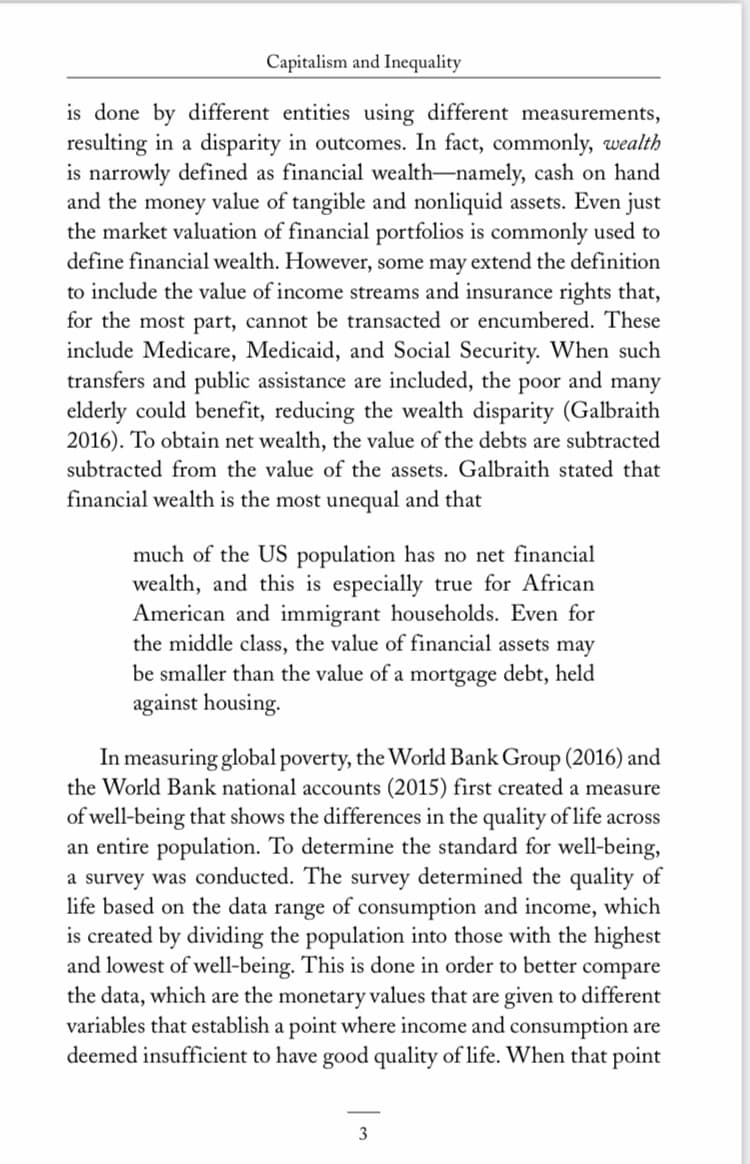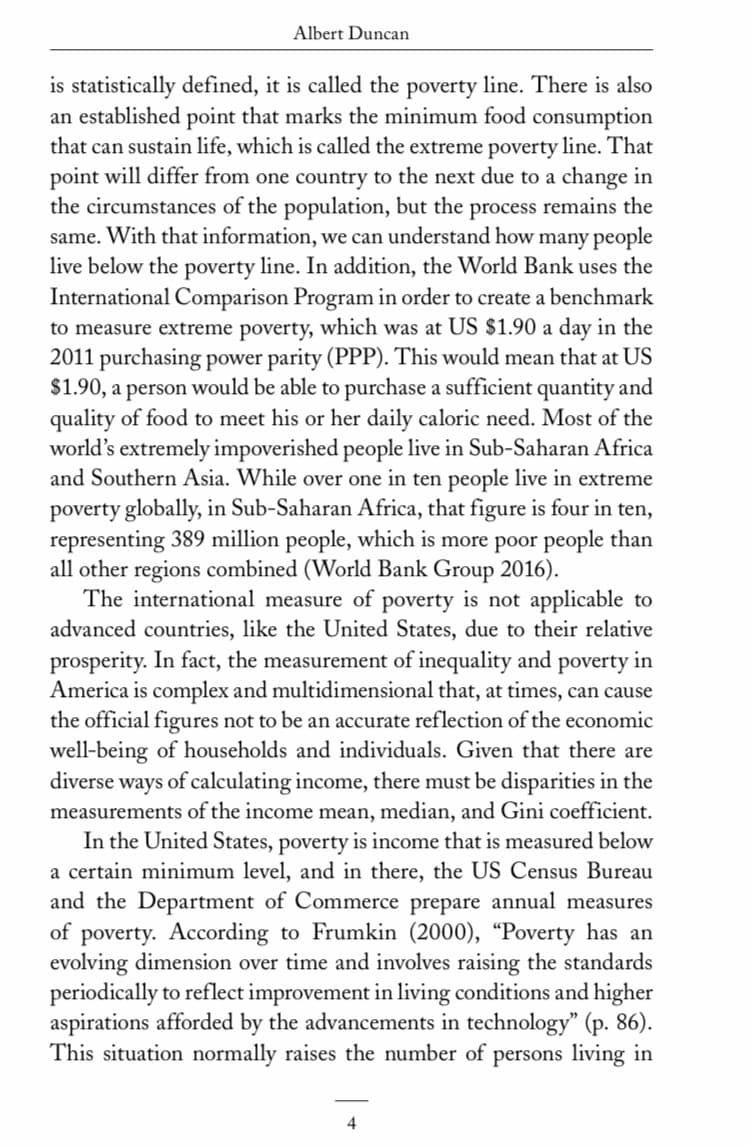Chapter1: Making Economics Decisions
Section: Chapter Questions
Problem 1QTC
Related questions
Question
-what are some of the dimensions of economic inequality and what is considered income?

Transcribed Image Text:Capitalism and Inequality
is done by different entities using different measurements,
resulting in a disparity in outcomes. In fact, commonly, wealth
is narrowly defined as financial wealth-namely, cash on hand
and the money value of tangible and nonliquid assets. Even just
the market valuation of financial portfolios is commonly used to
define financial wealth. However, some may extend the definition
to include the value of income streams and insurance rights that,
for the most part, cannot be transacted or encumbered. These
include Medicare, Medicaid, and Social Security. When such
transfers and public assistance are included, the poor and many
elderly could benefit, reducing the wealth disparity (Galbraith
2016). To obtain net wealth, the value of the debts are subtracted
subtracted from the value of the assets. Galbraith stated that
financial wealth is the most unequal and that
much of the US population has no net financial
wealth, and this is especially true for African
American and immigrant households. Even for
the middle class, the value of financial assets may
be smaller than the value of a mortgage debt, held
against housing.
In measuring global poverty, the World Bank Group (2016) and
the World Bank national accounts (2015) first created a measure
of well-being that shows the differences in the quality of life across
an entire population. To determine the standard for well-being,
a survey was conducted. The survey determined the quality of
life based on the data range of consumption and income, which
is created by dividing the population into those with the highest
and lowest of well-being. This is done in order to better compare
the data, which are the monetary values that are given to different
variables that establish a point where income and consumption are
deemed insufficient to have good quality of life. When that point
3

Transcribed Image Text:Albert Duncan
is statistically defined, it is called the poverty line. There is also
an established point that marks the minimum food consumption
that can sustain life, which is called the extreme poverty line. That
point will differ from one country to the next due to a change in
the circumstances of the population, but the process remains the
same. With that information, we can understand how many people
live below the poverty line. In addition, the World Bank uses the
International Comparison Program in order to create a benchmark
to measure extreme poverty, which was at US $1.90 a day in the
2011 purchasing power parity (PPP). This would mean that at US
$1.90, a person would be able to purchase a sufficient quantity and
quality of food to meet his or her daily caloric need. Most of the
world's extremely impoverished people live in Sub-Saharan Africa
and Southern Asia. While over one in ten people live in extreme
poverty globally, in Sub-Saharan Africa, that figure is four in ten,
representing 389 million people, which is more poor people than
all other regions combined (World Bank Group 2016).
The international measure of poverty is not applicable to
advanced countries, like the United States, due to their relative
prosperity. In fact, the measurement of inequality and poverty in
America is complex and multidimensional that, at times, can cause
the official figures not to be an accurate reflection of the economic
well-being of households and individuals. Given that there are
diverse ways of calculating income, there must be disparities in the
measurements of the income mean, median, and Gini coefficient.
In the United States, poverty is income that is measured below
a certain minimum level, and in there, the US Census Bureau
and the Department of Commerce prepare annual measures
of poverty. According to Frumkin (2000), “Poverty has an
evolving dimension over time and involves raising the standards
periodically to reflect improvement in living conditions and higher
aspirations afforded by the advancements in technology" (p. 86).
This situation normally raises the number of persons living in
4
Expert Solution
This question has been solved!
Explore an expertly crafted, step-by-step solution for a thorough understanding of key concepts.
This is a popular solution!
Trending now
This is a popular solution!
Step by step
Solved in 2 steps

Knowledge Booster
Learn more about
Need a deep-dive on the concept behind this application? Look no further. Learn more about this topic, economics and related others by exploring similar questions and additional content below.Recommended textbooks for you


Principles of Economics (12th Edition)
Economics
ISBN:
9780134078779
Author:
Karl E. Case, Ray C. Fair, Sharon E. Oster
Publisher:
PEARSON

Engineering Economy (17th Edition)
Economics
ISBN:
9780134870069
Author:
William G. Sullivan, Elin M. Wicks, C. Patrick Koelling
Publisher:
PEARSON


Principles of Economics (12th Edition)
Economics
ISBN:
9780134078779
Author:
Karl E. Case, Ray C. Fair, Sharon E. Oster
Publisher:
PEARSON

Engineering Economy (17th Edition)
Economics
ISBN:
9780134870069
Author:
William G. Sullivan, Elin M. Wicks, C. Patrick Koelling
Publisher:
PEARSON

Principles of Economics (MindTap Course List)
Economics
ISBN:
9781305585126
Author:
N. Gregory Mankiw
Publisher:
Cengage Learning

Managerial Economics: A Problem Solving Approach
Economics
ISBN:
9781337106665
Author:
Luke M. Froeb, Brian T. McCann, Michael R. Ward, Mike Shor
Publisher:
Cengage Learning

Managerial Economics & Business Strategy (Mcgraw-…
Economics
ISBN:
9781259290619
Author:
Michael Baye, Jeff Prince
Publisher:
McGraw-Hill Education